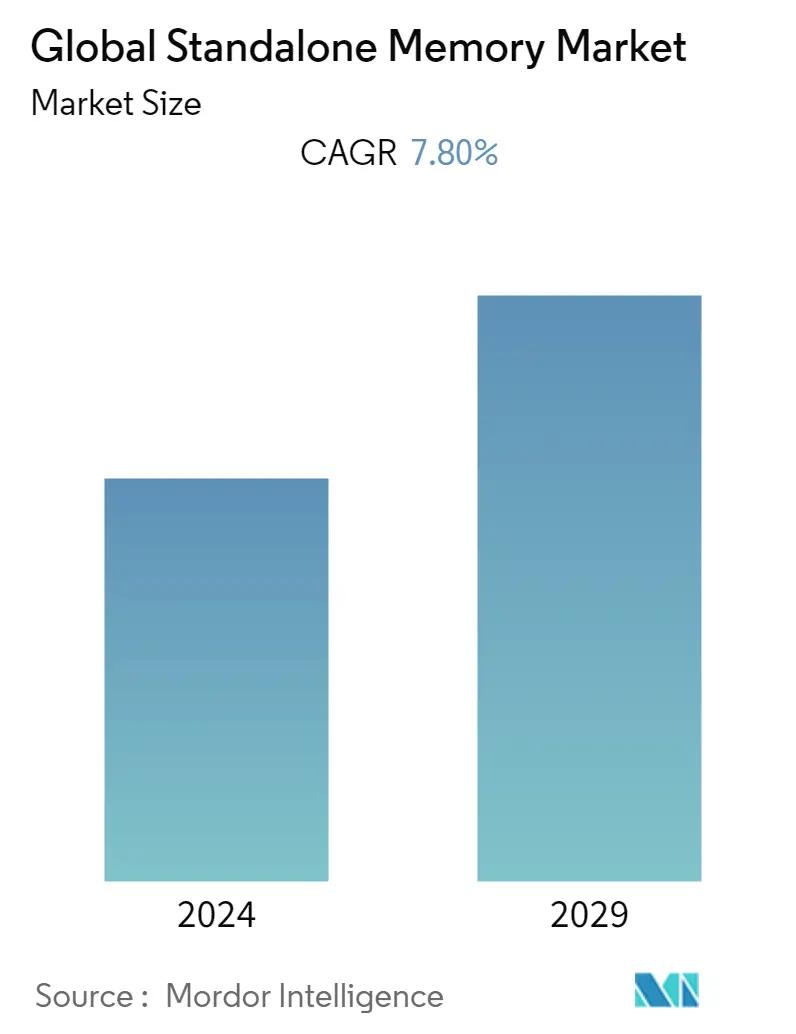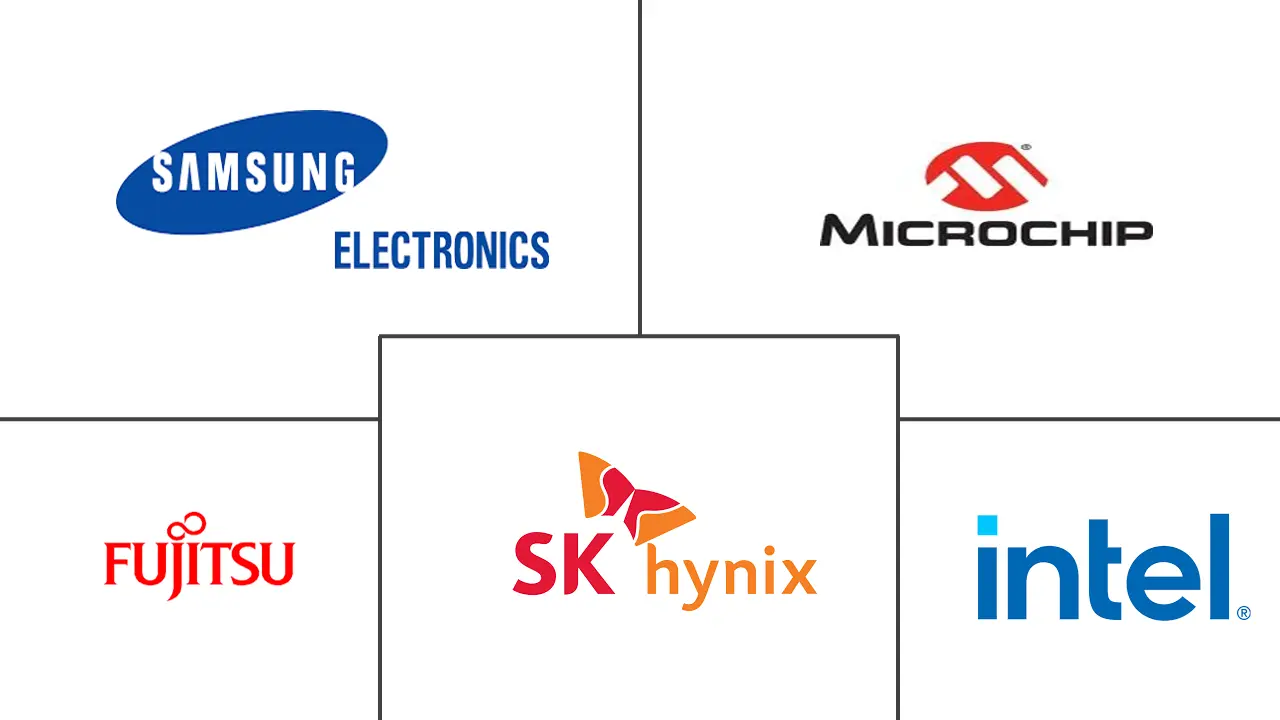Market Size of Global Standalone Memory Industry

| Study Period | 2019 - 2029 |
| Base Year For Estimation | 2023 |
| CAGR | 7.80 % |
| Fastest Growing Market | Asia-Pacific |
| Largest Market | North America |
| Market Concentration | Medium |
Major Players
*Disclaimer: Major Players sorted in no particular order |
Standalone Memory Market Analysis
The Global Standalone Memory Market is expected to register at a CAGR of 7.8% over the forecast period (2022-2027). Despite the downturn, demand for internet service providers (ISPs), IT infrastructure providers, and data centers has increased, owing to the move toward home and remote working. Several trends in enterprise data centers have increased because of the COVID-19 pandemic, which is driving market growth.
- The increasing use of internet of things devices and adoption of sensor technology such as wearable and AI-enabled devices have boosted demand for fast data transfers and high storage density, providing a tremendous chance or possibility for the growth of the standalone memory market globally. According to Applied Materials, the exponential volumes of data generated via IoT and edge devices and by internet users act as a catalyst to drive the commercialization of such memory. Artificial intelligence and data analytics applications are largely driving the demand for this data.
- The exponential growth of data generated shows no indications of abating. During the COVID-19 pandemic, the work-from-home trend resulted in a massive data increase through applications such as video conferencing. New applications, such as AI and AR/VR, are projected to become commonplace in the forecast period, resulting in a further data boom. As a result of the increase in data, memory technology is being pushed to new standards. To fulfill these demands, DRAM and NAND have scaled up.
- Additional memory technologies, on the other side, must be developed to keep up with the data growth. In September 2021, SK Hynix, a South Korean firm, stated that three new technologies, STT-MRAM, Ferroelectric Memory, and ReRAM, could play a role in processing larger quantities of data.
- The rising need to handle the proliferation of data due to the adoption of IoT further drives the market. The adoption of IoT devices is taking place at a rapid pace. Various government initiatives worldwide, like smart cities, are supporting the deployment of these devices at a much faster pace.
Standalone Memory Industry Segmentation
Standalone memory includes dynamic random access memory (DRAM), ferroelectric RAM (FRAM), static RAM (SRAM), NAND, and NOR. The study covers standalone types across major end-users such as automotive, consumer electronics, and industrial. The study also covers demand across various regions and considers the impact of COVID-19 on the market.
| By Product Type | |
| DRAM | |
| NAND | |
| NOR | |
| (NV)SRAM /FRAM | |
| Other Product Types |
| By End-User Industry | |
| Automotive | |
| Consumer Electronics | |
| Enterprise | |
| Other End-user Industries |
| By Geography | |
| North America | |
| Europe | |
| Asia Pacific | |
| Rest of the World |
Global Standalone Memory Market Size Summary
The Global Standalone Memory Market is poised for significant growth, driven by the increasing demand for high-performance memory solutions across various sectors. The shift towards remote working and the rise of IoT devices have amplified the need for fast data transfers and high storage density, creating substantial opportunities for market expansion. The proliferation of data generated by IoT and edge devices, coupled with the growing applications of artificial intelligence and data analytics, is propelling the demand for advanced memory technologies. The automotive sector, particularly with the advent of autonomous vehicles and advanced driver assistance systems, is also contributing to the market's growth by necessitating the integration of high-capacity memory solutions. Innovations in memory technologies, such as DRAM, NAND, STT-MRAM, Ferroelectric Memory, and ReRAM, are being developed to meet the escalating data demands.
Regionally, the Asia Pacific stands out as a significant contributor to the standalone memory market, driven by its robust semiconductor manufacturing industry and burgeoning consumer electronics and automotive sectors. Countries like China, India, Japan, and South Korea are at the forefront, with substantial investments and initiatives supporting the deployment of advanced memory solutions. The market is characterized by moderate competition, with key players like Samsung Electronics, SK Hynix, Microchip Technology, Fujitsu Semiconductor Memory Solution, and Intel Corporation leading the charge in innovation and product development. These companies are continuously enhancing their offerings to cater to the evolving demands of high-bandwidth applications in supercomputing, AI, and machine learning, further bolstering the market's growth trajectory.
Global Standalone Memory Market Size - Table of Contents
-
1. MARKET INSIGHTS
-
1.1 Market Overview
-
1.2 Industry Attractiveness - Porter's Five Forces Analysis
-
1.2.1 Bargaining Power of Suppliers
-
1.2.2 Bargaining Power of Buyers
-
1.2.3 Threat of New Entrants
-
1.2.4 Threat of Substitutes
-
1.2.5 Intensity of Competitive Rivalry
-
-
1.3 Assessment of COVID-19 Impact on the Market
-
-
2. MARKET SEGMENTATION
-
2.1 By Product Type
-
2.1.1 DRAM
-
2.1.2 NAND
-
2.1.3 NOR
-
2.1.4 (NV)SRAM /FRAM
-
2.1.5 Other Product Types
-
-
2.2 By End-User Industry
-
2.2.1 Automotive
-
2.2.2 Consumer Electronics
-
2.2.3 Enterprise
-
2.2.4 Other End-user Industries
-
-
2.3 By Geography
-
2.3.1 North America
-
2.3.2 Europe
-
2.3.3 Asia Pacific
-
2.3.4 Rest of the World
-
-
Global Standalone Memory Market Size FAQs
What is the current Global Standalone Memory Market size?
The Global Standalone Memory Market is projected to register a CAGR of 7.80% during the forecast period (2024-2029)
Who are the key players in Global Standalone Memory Market?
Samsung Electronics Co. Ltd, Microchip Technology Inc., SK Hynix Inc., Fujitsu Semiconductor Memory Solution (Fujitsu Group) and Intel Corporation are the major companies operating in the Global Standalone Memory Market.

